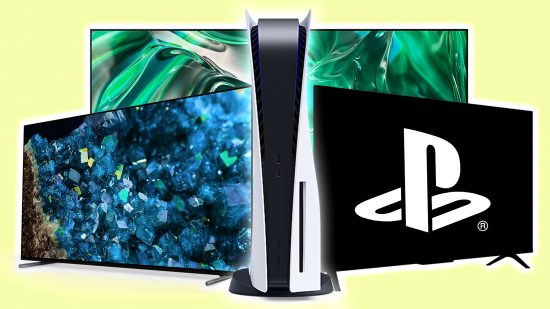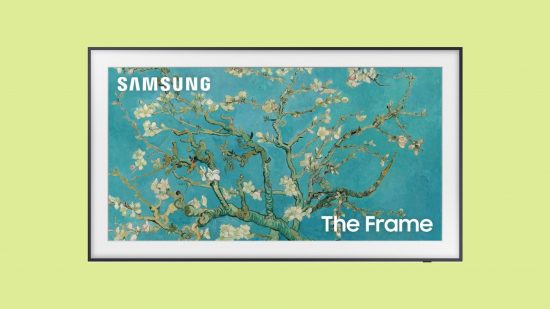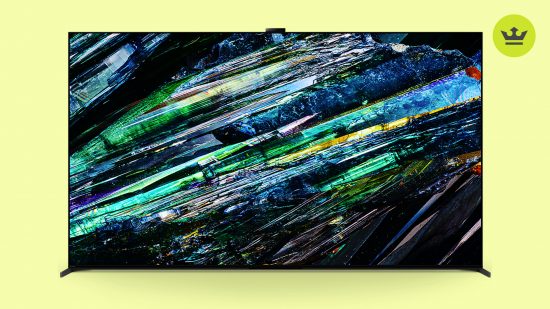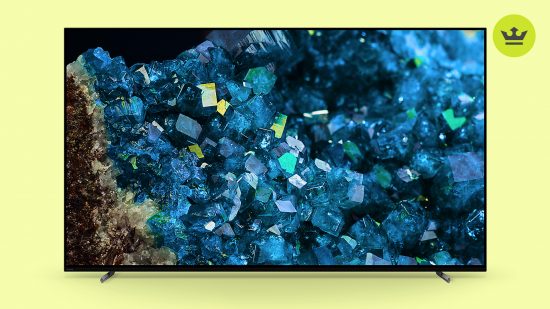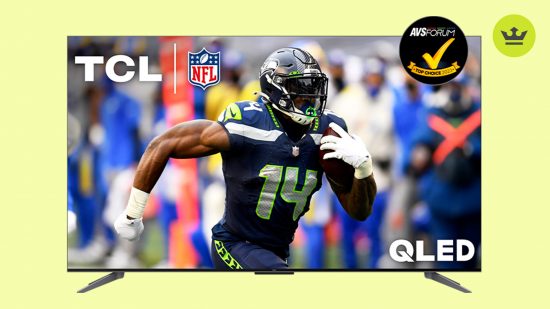The best gaming TV will enhance your gaming experience, giving you better visuals, low input lag, high refresh rates, and excellent audio quality. Gaming TVs also typically offer more responsive gameplay and give you a competitive edge in fast-paced games.
You’ll want high refresh rates, such as 120Hz or 240Hz, which will give you smoother motion during gameplay. Some also have variable refresh rate (VRR) technology like G-Sync or FreeSync, which maintains a consistent frame rate. HDMI 2.1 connectivity with the best HDMI cables will also help you get the most out of the PS5 or Xbox Series X.
Most gaming TVs are also smart TVs, with streaming apps and voice control making them entertainment devices in their own right. The TVs in this guide support the best gaming consoles, so whether you play on a PS5, PS4, Xbox One, Xbox Series X, Series S, or even Nintendo Switch, you’ll find a TV to match your needs and budget.
Why you can trust us ✔ At The Loadout, our experts spend hours testing hardware and game. We share honest advice to help you buy the best. Find out how we test.
The best gaming TV in 2024:
- Samsung S90C – best for most people
- Sony 4K Ultra HD – best affordable gaming TV
- Samsung Neo QLED 4K – best mid-range TV
- Hisense A6G – best budget 4K TV
- Samsung The Frame – best TV for Xbox Series X
- LG OLED B2 Series – best TV for Nintendo Switch
1. Samsung S90C
The best gaming TV for most people.
Samsung S90C specs:
| Available sizes (inches) | 55, 65, 77 |
| Resolution | 4K |
| Smart platform | Samsung Tizen |
| Refresh rate | 144Hz |
| High dynamic range | HDR10+, HDR10, HLG |
| HDMI 2.1 ports | 4 |
Pros
- Reasonably priced
- Vibrant picture quality with a lot of contrast
Cons
- Less bright than other models
- Sound quality surpassed by other TVs
If you’re after a new television and your number one concern is getting something that is going to be good for gaming, then the Samsung S90C is going to be your best bet. Samsung’s attempt to make QD-OLED technology more affordable has paid off wonderfully, with a television can offer beautifully crisp and clear picture quality without being excessively costly.
Admittedly, there are TVs that offer slightly better sound and picture quality, but you can essentially go up endlessly on those fronts if money is no object. As it stands, the Samsung S90C offers full 4K 120Hz, and has a dedicated gaming mode to ensure that it is properly optimized for your console (or gaming PC) of choice. For the asking price, that’s pretty fantastic.
2. Sony 4K Ultra HD TV
Best cheap gaming TV.
Sony 4k Ultra HD TV specs:
| Available sizes (inches) | 43, 50, 55, 65, 75, 85 |
| Resolution | 4k (2160p) |
| Smart platform | Google TV |
| Refresh rate | 120hz |
| High dynamic range | Yes |
| HDMI 2.1 ports | 4 |
Pros
- Reasonably priced
- Exclusive features for PS5
Cons
- Smaller screen size
- Lower picture quality
The Sony 4K Ultra HD TV is one of the cheaper gaming TVs, because of its smaller screen size and lower resolution. While this is true in comparison to other products on this list, when considered on its own, these aren’t issues at all.
It has a dedicated game mode that you can turn on whenever you want a gaming session, ensuring that you’re using the full extent of the PS5’s power. With 4 HDMI ports, you can keep multiple consoles plugged in at the same time too. If you’ve just bought a new console, the smaller price tag might make this TV ideal for you.
3. Samsung Neo QLED 4K Smart TV
Best mid-range gaming TV.
Samsung Neo QLED 4K Smart TV specs:
| Available size (inches) | 55, 65, 75, 85 |
| Resolution | 4k (2160p) |
| Smart platform | Tizen |
| Refresh rate | 120hz |
| High dynamic range | Yes |
| HDMI 2.1 ports | 4 |
Pros
- Not excessively expensive
- Various hands-free options
Cons
- Text can occasionally be hard to read
- Remote control can be confusing
The Samsung Neo QLED 4k Smart TV is priced competitively for its size and features. This television uses Quantum HDR 32X picture quality enhancement technology to make everything you play (or watch) look as crisp as possible. This ensures that you’re able to experience Xbox Series X and PS5 games in the way they were intended, but older games will be given an extra layer of polish to bring them closer to modern standards.
Unlike our choice for the best gaming TV, the Samsung Neo has plenty of hands-free options for Google Assistant (and Alexa). This is a TV that makes it easy for you to share your screen from other devices too, so if you’re somebody who also likes to dabble with the best mobile games, then you may even be able to experience them on the big screen too.

4. Hisense A6G
The best budget 4K gaming TV.
Hisense A6G specs:
| Available sizes (inches) | 43, 50, 55, 65, 75 |
| Resolution | 4k (2160p) |
| Smart platform | Google TV |
| Refresh rate | 60hz |
| High dynamic range | Yes |
| HDMI 2.1 ports | 0 |
Pros
- Great value for money
- Features HDR
Cons
- Poor contrast and low brightness
- Lacking features of higher-end TVs, particularly 120Hz
If you’re on a strict budget but still want a great 4K gaming TV for your PS5 or Xbox Series X|S setup, then you can’t beat the Hisense A6G. Sure, you won’t get the full range of features that higher-end gaming TVs have, especially a 120Hz refresh rate, but it’s 4K 60Hz performance is nothing to scoff at. You’ll get great detail and precision when you’re gaming, including HDR support for deeper colors. You get a great bang for your buck.
However, as a more budget-friendly option, there are more downsides to consider. In general, the Hisense A6G struggles when it comes to brightness. When gaming, the darkness, lack of local dimming functionality, and general black uniformity reduce the quality of the image compared to more expensive options.
Despite the flaws, it’s hard to argue with the price. It is a budget option and that’s not a bad thing. Though we don’t recommend it those those who can fork out for pricier options, the Hisense A6G is a great TV at a great price.
5. Samsung The Frame QLED 4K Smart TV
Best-designed gaming TV.
Samsung’s The Frame specs:
| Aspect | Details |
| Available sizes (inches) | 32, 43, 50, 55, 65, 75, 85 |
| Resolution | 4K (2160p) |
| Smart platform | Tizen |
| Refresh rates | 120hz |
| High dynamic range | Yes |
| HDMI 2.1 ports | 4 |
Pros:
- Compatible with Xbox Cloud Gaming
- Slim, subtle, artistic
Cons:
- Expensive
- Can be hard to place
The Frame has been designed to look like a painting hanging on the wall. It’s gorgeous and would make a fine addition to many a living room or gaming space. It’s also compatible with the Xbox Cloud Gaming service.
Technically, you don’t even need an Xbox Series X to be able to play its games on this television. With the Cloud Gaming service, you can just stream the games directly through your TV. While the service is still in beta, almost all Game Pass games are compatible, so you could buy the TV before you’re committed to the console and try out some of the games in its library.
This is a top-of-the-range 4K TV that’ll ensure you’re getting the most out of this powerful console’s processing power. And when you’re not playing games, you can set the screen to default to historic paintings. The gimmick behind this TV is probably going to seem amazing to some and pointless to others, which is something to bear in mind given its high price tag.
6. LG OLED B2 Series
Best Nintendo Switch gaming TV.
LG OLED B2 Series specs:
| Aspect | Details |
| Available sizes (inches) | 55, 65, 77 |
| Resolution | 4k (2160p) |
| Smart platform | webOS |
| Refresh rates | 120hz |
| High dynamic range | Yes |
| HDMI 2.1 ports | 2 |
Pros
- Beautiful OLED screen
- Excellent 120Hz refresh rate
Cons
- Screen is a little reflective
- Could be brighter
Did you buy the Nintendo Switch OLED and feel disappointed that the enhanced picture quality didn’t extend to your television? With this OLED screen, you’ll have the same level of visual enhancement as on the Switch OLED screen, except on a larger scale – the best Nintendo Switch games have never looked better.
The 120hz refresh rate is plenty for Switch games, however, it falls flat with some brighter, more vibrant games. This is one of the cheaper televisions that we’ve included on this list, and considering that low price, it’s hard to be too frustrated with its small handful of downsides. No TV is perfect, but if you want one that’s going to pair well with your Switch and be good for playing on, then you can’t go wrong with the LG B2 series.
Best TV for PS5
The best PS5 TVs in 2024:
- LG G3 – Best PS5 TV overall
- Sony A95L – Best PS5 TV with dedicated features
- Samsung S95C – Best PS5 TV for PC owners
- Sony A80L – Best mid-range PS5 TV
- TCL Q7 – Best PS5 TV below $1,000
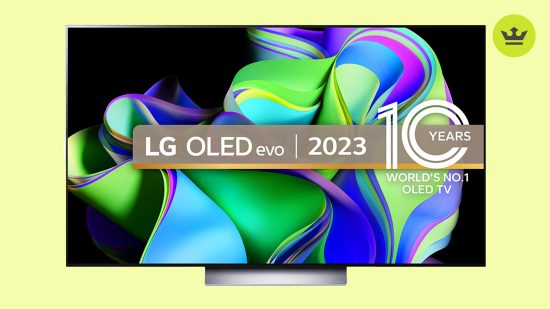
1. LG G3
The best PS5 TV overall
LG G3 specs:
| Available sizes (inches) | 42, 48, 55, 65, 77, 83 |
| Resolution | 4K @ 120Hz |
| Smart platform | LG system |
| Refresh rate | 120Hz |
| High dynamic range | Dolby Vision, HDR10, HLG |
| HDMI 2.1 ports | 4 |
Pros
- Immense picture quality in all lighting
- 5-year warranty
- WebOS massively improved from previous iterations
Cons
- Sound quality could be better for the price
- Color depth lacking compared to QD-OLED options
- MLA only available on 55/65/77-inch models
If you’re looking for unparalleled color reproduction, response times, and perfect blacks, then OLED displays are still the top dogs by a large margin. In 2024, the OLED market has gotten even more exciting, and when it comes to getting the most out of the PS5 the LG G3 is our pick of the bunch right now.
While OLED traditionally suffers on the brightness front compared to its LCD counterparts, LG has cracked the code with its Micro Lens Array (MLA) technology. MLA refocuses light that would otherwise be wasted, bending it back towards the viewer. The result is a vastly brighter picture, without increasing burn-in risk – even in the highly unlikely event that burn-in does occur, LG’s generous 5-year warranty will soon see to it.
The G3 promises just over 2,000 nits in luminance – that’s double what your standard OLED of yesteryear is capable of – so if you’re gaming in a bright room and need that extra oomph, then glare won’t be an issue.
While it may lack the Quantum Dot OLED (QD-OLED) tech currently found in the Samsung S95C and Sony A95L, LG’s advanced sixth-generation a9AI processor makes full use of that MLA panel to create a stunning, detailed image that helps make up for some of the lost color depth and luminance you get from the competitor sets. As a result, gaming on PS5 with the G3 is an absolute dream.
The G3 isn’t perfect though, and its greatest flaw undoubtedly lies in its audio. While we do think the G3’s built-in 60W 4.2 channel speakers are fine for the most part, the performance of its audio array doesn’t match up with the A95L and S95C’s. We’d recommend investing in a solid soundbar if you do opt for the LG, though this should be a default investment for any high-end OLED if you’re looking to match the quality of what you hear with what you see.
One tertiary element that should be noted is that the G3 doesn’t come with a stand, but it does come with a gapless wall mount – something LG calls a “One Wall Design”. If you’re looking for a seamless gaming setup, then this is an excellent design consideration. However, if you have a cabinet or table ready to go, then you will have to fork out for a stand.
2. Sony A95L
The best PS5 TV with dedicated features.
Samsung A95L specs:
| Available sizes (inches) | 55, 65, 77 |
| Resolution | 4K @ 120Hz |
| Smart platform | Google TV |
| Refresh rate | 120Hz |
| High dynamic range | Dolby Vision, HDR10, HLG |
| HDMI 2.1 ports | 2 |
Pros
- Best color accuracy out of the box
- Multi-View is a handy gimmick
- Better native audio than Samsung and LG
Cons
- Far pricier than competitors
- Limited size options
If you’re a PS5 owner, it makes sense to purchase a gaming TV from Sony. The Japanese company has been a major player in the audiovisual market for over half a century, and it should come as no surprise that it’s incorporated its PS5-specific bells and whistles into many of its TVs.
While the quantum dots found within the A95L’s QD-OLED panel might not produce an image that’s quite as bright as the G3’s MLA tech, it’s incredibly close. Additionally, it sports the most accurate colors out of the box out of the OLED options on this list, which is huge if you don’t want to mess with picture settings or pay for it to be professionally calibrated.
When it comes to PS5 integration, Sony’s auto HDR mapping will automatically optimize your PS5’s HDR settings when it’s hooked up – one more group of settings you won’t have to mess with. Furthermore, ‘Auto Genre Picture Mode’ – Sony’s way of saying the A95L has an Auto Low Latency Mode – will naturally kick in when it’s gaming time, maximizing responsiveness and reducing lag.
The most interesting new gaming quirk from Sony this year is the introduction of MultiView, which allows you to multitask on your A95L. This means you can play the best PS5 games on one half of your screen while watching guides for them on the other. It might hamper the immersion to an extent, but it’ll certainly save you from having to fiddle with your phone or another device if you need a hand when, say, figuring out what the best starting class in Lords of the Fallen is.
The A95L’s greatest limitation currently is its price, seeing as it’s noticeably more expensive than both the LG G3 and Samsung S95C. Having only launched at the beginning of Q4 2023 in the US, this is to be expected considering that both competitor models were released several months prior, and have already gone on sale.
Is the A95L good enough to merit the extra ~$1,000 investment? We think so only if you really want the best performance possible out of the box, with minimal tweaks.

3. Samsung S95C
The best PS5 TV for PC owners.
Samsung S95C specs:
| Available sizes (inches) | 55, 65, 77 |
| Resolution | 4K @ 144Hz |
| Smart platform | Tizen |
| Refresh rate | 144Hz |
| High dynamic range | HDR10+, HLG |
| HDMI 2.1 ports | 4 |
Pros
- One of the only 144Hz OLED panels on the market
- HDR10+ support
- Excellent Gaming Hub
Cons
- No Dolby Vision
- No DTS pass-through
- Limited size options
If you have a high-end gaming PC that you’re also hoping to pair with your TV, alongside your PS5, then Samsung’s S95C gets the nod from us. While the LG G3 and Sony A95L have a maximum refresh rate of 120Hz at 4K, the S95C is the first Samsung OLED panel to run at 4K 144Hz – a standard that very few TVs on the market currently support.
Although the S95C only officially supports AMD FreeSync Premium Pro, RTINGS.com has confirmed that G-Sync compatibility is there, even though the S95C hasn’t been certified by NVIDIA – only the G3 and some of LG’s other OLED TVs have that privilege. This is by no means a dealbreaker, as the Premium Pro version of FreeSync grants access to VRR in HDR content, reducing or, in some cases, eliminating tearing and visual artifacts altogether.
As with the A95L, the S95C produces brighter colors with more depth to them than those on the G3. However, you won’t find Dolby Vision or DTS pass-through on this TV – a major consideration depending on the sort of content you watch, and the home theater setup you might already have in place.
An additional noteworthy feature is the Samsung One Connect unit included in the package, which is a perfect solution for individuals seeking a clutter-free, relatively wire-free appearance. All you need to do is link all your external devices to this unit and then connect it to the S95C using a single cable, and you’re good to go.
4. Sony A80L
The best mid-range TV for PS5.
Sony A80L specs:
| Available sizes (inches) | 55, 65, 77, 83 |
| Resolution | 4K @ 120Hz |
| Smart platform | Google TV |
| Refresh rate | 120Hz |
| High dynamic range | Dolby Vision, HDR10, HLG |
| HDMI 2.1 ports | 2 |
Pros
- OLED at a more modest price
- Excellent dedicated PS5 features
- Great, even sound
Cons
- No HDR10+
- Not as bright as modern OLED technologies
If your heart’s set on OLED, but you don’t want to spend a small fortune, then Sony’s A80L is the way to go. While the A80L doesn’t benefit from Samsung’s QD-OLED or LG’s MLA technologies, it’s still an impressive TV that will perform well under most normal lighting conditions.
As with the A95L, if you’re after a TV that you won’t have to rush out and buy a soundbar straight away, then you can’t go wrong here thanks to Sony’s Acoustic Surface Audio+. While it isn’t a substitute for a dedicated system, the way the A80L utilizes its actuators and subwoofers to vibrate the whole panel, creating even sound is very impressive.
With a monstrous 83-inch version available, and Dolby Vision included, the A80L isn’t only a great TV for playing PS5 games on, but it will also make for a fine addition to any home cinema setup.
5. TCL Q7
Best TV for PS5 under $1,000.
TCL Q7 specs:
| Available sizes (inches) | 55, 65, 75, 85 |
| Resolution | 4K @ 144Hz (VRR) / 1080p @ 240Hz (VRR) |
| Smart platform | Google TV |
| Refresh rate | 240Hz |
| High dynamic range | Dolby Vision+, HDR PRO+, HDR10+, HDR10, HLG |
| HDMI 2.1 ports | 1 |
Pros
- Comprehensive gaming feature set
- Up to 240Hz VRR with Game Accelerator
- Quantum Dot LED technology at a bargain price
Cons
- Ghosting can occur at 240Hz
- The panel requires calibration to get the best out of it
If you’re looking for a PS5 gaming TV that’s stuffed with high-end features but won’t break the bank, then you can’t go wrong with the TCL Q7.
While the Q7 utilizes a QLED panel, rather than an OLED, it still runs natively at 120Hz, which is perfect for the PS5’s needs. Even more impressive is that the Q7 extends its support to the complete trifecta of HDR10, HDR10+, and Dolby Vision IQ. This guarantees that anything you watch or play will look its best – panel limitations considered – which is a major boon over even the premium OLED options on this list. You’ll also get both Dolby Atmos and DTS pass-through support.
Although the Q7’s picture is serviceable at best out of the box – it certainly won’t be beating any of the OLED panels for contrast or color – the welcomed inclusion of Full Array Local Dimming dynamically bolsters its contrast, giving its dynamic range a major lift. With a proper tune-up on top of this, the Q7 can shine.
When it comes to gaming on PS5, the Q7’s game bar might not be as sophisticated as LG, Samsung, or Sony’s, but there’s still enough there to let you tweak picture modes and shadows, or even check your current FPS while in-game. You also get FreeSync Premium Pro, as well as ALLM so you won’t have to worry about tearing.
As for the Q7’s stand-out gaming feature, Game Accelerator, you can halve the TV’s native 4K resolution to double the refresh rate of its panel to 240Hz. While this won’t do much for PS5 gameplay – it’s locked to 120Hz at best, after all – if you do have a PC you want to hook up then this is an excellent option for bolstering your experience. With that said, however, we found that there was noticeable ghosting with certain games at 240Hz, so be warned.
HDR10 vs HDR10+
HDR10 and HDR10+ are two competing high dynamic range (HDR) video formats used to display content. They both aim to improve quality by offering a wider range of colors, greater contrast, and more detail in the highlights and shadows. There are, however, several key differences between the two:
- Age: HDR10 first debuted as an open format in 2015, while HDR10+ was an iterative leap developed by Samsung and Amazon Prime Video that launched in 2017
- Metadata: HDR10 uses static metadata, which means that content is mastered with a single tonal curve for its entire duration. This can limit the accuracy of HDR representation, as it doesn’t account for scene-specific variations in brightness and color. As with Dolby Vision, HDR10+ allows image metadata to shift continuously, enabling dynamic tone mapping on a scene-by-scene basis.
- Brightness: HDR10+ has a greater brightness standard of 4,000 nits compared to HDR10’s 1,000 nits.
- Color depth: While both formats typically use 10-bit color depth, providing over a billion colors, HDR10+ is capable of 12-bit color depth. This can provide 68.7 billion colors.
- Adoption: HDR10 is adopted more widely than HDR10+ by far, thanks to it being an open format.
While HDR10+ has more upsides than HDR10, poor implementation of the technology can lead to images looking uneven as the TV’s processor struggles to apply it to each scene. When it comes to opting for one of these technologies purely for your PS5, we wouldn’t recommend shelling out extra for HDR10+ as the console doesn’t support it.
With that said, if you are also looking to watch HDR content, then HDR10+ and Dolby Vision are both great additional options. You do need to be careful, though, as the dynamic tone mapping on cheaper TVs can be jarring because of that sub-standard implementation.
How to choose the best gaming TV
Gaming TVs need more specific testing than the best TVs, with a low input lag so that there’s no delay between pressing a button on the controller and seeing the effect on screen. It’s also a good idea to consider the price, brand reputation, size, and compatibility with your console of choice.
- Pricing: Gaming TVs start at around $700 (£650) and can cost upwards of $2,000 ($2,000). Unless you’re a professional gamer or have a significant budget, consider what features are essential and narrow down your options by price bracket.
- Reliable brands: When it comes to a big purchase like a gaming TV, well-known brands usually offer better warranties. To give you confidence, we’ve included brands with the best reputation for quality.
- Size: Everyone has a different amount of space. Gaming TVs start from around 43 inches and can reach huge dimensions of more than 70 inches. It’s a good idea to measure your intended TV space and consider how far away from the screen you’ll be sitting. A TV that’s top big will be overwhelming, but a screen that’s too small will make it difficult to see finer details.
- Picture quality: Does the gaming TV have an OLED screen? What’s the resolution? The highest picture quality will come at a higher price, but 4K is the minimum we’d recommend for a gaming TV in 2024.
- Gaming features: Many of these TVs are specifically compatible with the likes of GeForce Now or Xbox Cloud Gaming. Sony TVs have features that are tailored to the PlayStation 5.
To build your perfect gaming space, check out our guide to the best gaming desks.
